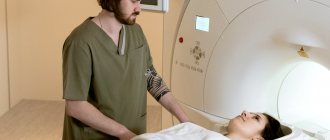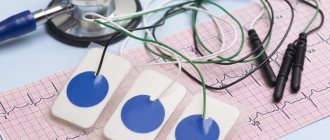Bradycardia is a type of arrhythmia when the frequency of contractions of the heart muscle is less than 60 beats per minute. It can occur as a norm in athletes, but bradycardia often indicates various cardiac pathologies. One of the characteristic manifestations is weakness, fainting and short-term loss of consciousness, cold sweat, pain in the heart, dizziness, and instability of blood pressure. If the patient has severe disease (less than 40 heart beats per minute), heart failure may develop. In this case, for the effective treatment of cardiac bradycardia, surgery to implant a pacemaker is indicated.
Symptoms and signs
Bradycardia has clinical symptoms and objective signs. Objective signs of bradycardia are pulse rate and changes in ECG readings. Clinical manifestations include various complaints of poor health. Among the symptoms of bradycardia, the most common are:
- feeling of lack of air;
- swelling;
- lowering blood pressure;
- fainting;
- pallor of the mucous membranes and skin;
- state of general weakness;
- convulsions;
- fast fatiguability;
- short-term visual impairment;
- dyspnea;
- dizziness;
- low concentration, absent-mindedness.
The symptoms of bradycardia presented above, as a rule, have different levels of severity. It is worth noting that with bradycardia, both all of the listed symptoms, and only some of them, develop. They are not specific, so they are often mistaken by patients for signs of other diseases or aging. If sinus bradycardia is maintained at a level of 40–59 beats per minute, the person does not experience any clinical symptoms. If the heart rhythm disturbance reaches 30–40 beats/min, fatigue, weakness occurs, attention and memory deteriorate, shortness of breath, swelling, dizziness appear, vision is impaired, and the skin turns pale. When the heart rate decreases to 30 beats per minute or less, a person may experience seizures or fainting. In case of loss of consciousness due to severe bradycardia, urgent medical assistance should be provided to prevent respiratory arrest with further death.
Symptoms of the disease
Moderate course is rarely accompanied by obvious clinical symptoms. A severe form of pathology provokes:
- dizziness;
- weakness;
- fainting conditions;
- decreased muscle tone;
- blood pressure surges;
- profuse sweating.
Patients may experience difficulty breathing and severe chest pain. Representatives of the older age group are faced with impaired concentration, short-term memory loss, and episodic visual impairment.
Violation of myocardial contractile function leads to cerebral hypoxia. In the background, attacks of convulsions lasting up to 60 seconds may develop. This condition is considered by cardiologists as the most dangerous with confirmed bradycardia. The patient needs urgent help, since prolonged attacks of convulsions provoke cessation of respiratory activity.
Are you experiencing symptoms of bradycardia?
Only a doctor can accurately diagnose the disease. Don't delay your consultation - call
Causes
The most common cause of bradycardia is atrioventricular block of the sinus node. The reason for this process lies in the degenerative change in muscle fibers, which are responsible for excitation and conduction of electrical impulses. It is important to consider that bradycardia can be associated with rheumatism, chronic heart disease, myocarditis and other diseases.
The medical history of a patient with sinus bradycardia may include information about the use of drugs that slow the heart rate (HR). There may also be evidence of impaired blood circulation in the brain due to vascular disease. The distal blockade directly influences the onset of the disease.
The causes of bradycardia can be not only specific, it can be caused by:
- excessive pressure on the carotid artery (tie or tight collar) or eyeballs (Aschner reflex);
- increased intracranial pressure (meningitis, bruises, swelling or swelling of the brain);
- ulcer of the duodenum and stomach.
There is a medicinal type of sinus bradycardia, which appears due to taking various drugs, including cardiac ones.
Another form of the disease is the consequences of poisoning the body with organophosphorus compounds, hepatitis, sepsis, typhoid fever, uremia, and chemicals. Intoxication helps slow down the conduction of electrical signals to the heart. This category also includes bradycardia, which is provoked by disturbances in potassium balance or calcium levels in the body.
Some of the most common reasons are:
- coronary heart disease (CHD), acute myocardial infarction, heart disease, arterial hypertension.
- changes in the heart muscle that occur with age.
- reflex effects, in particular being in cold water, powerful blows to the chest or neck.
- drug overdose.
Bradycardia in children
In children, heart rate depends on age:
- infants - 120 strokes;
- children under three years of age - 110 strokes;
- children 3-9 years old – 90-100 blows;
- 9-12 years – 80-85 beats;
- teenagers - 70-75 beats.
A sign of bradycardia in children is considered to be a decrease in heart rate by 20 units from normal. The subjective characteristics of the rhythm are taken into account, taking into account the child’s temperament, his build and weight.
Reasons why negative changes in the conduction system of the heart may develop:
- hypoxia ;
- heredity;
- poor functioning of the thyroid gland;
- impaired cerebral circulation in newborns;
- allergic reactions to medications;
- past infection, which is accompanied by changes in the water-electrolyte composition of the blood and dehydration;
- inflammatory processes in the heart muscle ( myocarditis , endocarditis );
- acquired (rheumatic heart disease) or congenital (septal defects, stenosis, tetralogy of Fallot ) heart defects ;
- increased intracranial pressure ;
- nicotine and lead poisoning;
- medication overdose;
- hypothermia.
Sinus bradycardia of the heart in children can be physiological in nature and manifest itself as a result of too rapid growth of the child during puberty. Teenagers during this period are susceptible to stress, mood swings and neuroses. The endocrine system lags behind in development compared to other organs and systems. Failures in metabolic processes lead to the development of arrhythmia.
Bradycardia in a 5-year-old child is most often detected during a medical examination (if no organ pathology from the cardiovascular system was detected before 5 years of age, then, most likely, a rare pulse is a physiological feature). Deviations worth paying attention to:
- lethargy, drowsiness , weakness;
- severe shortness of breath after running and playing;
- instability of blood pressure;
- swelling, cyanosis and pallor of the nasolabial triangle;
- chest pain;
- inattention, absent-mindedness and memory impairment;
- loss of appetite;
- attacks of weakness accompanied by a rush of sweat.
Only your local pediatrician and cardiologist will tell you what pills to take and what additional examination you need to undergo. You should not self-medicate your child.
Sinus bradyarrhythmia. What is it like in children?
Bradyarrhythmia in children is most often associated with pathologically high tone of the vagus nerve. The problem can occur with infectious diseases, vegetative-vascular dystonia, with genetic predisposition, and diseases of the thyroid gland. Bradyarrhythmia in children under 1 year of age is associated with disturbances in the development of thermoregulation. That is why when the ambient temperature decreases, the pulse rate also changes. In adolescents, rhythm disturbances are associated with the influence of the vagus nerve on the production of impulse contractions by the sinus node.
Diagnostics
Characteristic signs of sinus bradycardia can be identified by interviewing the patient and subsequent objective examination. The examination allows you to determine a rare pulse and respiratory arrhythmia. For patients with a more obvious degree of development of the disease, consultation with a cardiologist is recommended.
Thanks to an electrocardiographic study, it is possible to establish a rare heart rate, the presence of atrioventricular or sinoatrial block. If no episodes of bradycardia were detected during ECG registration, the method of 24-hour ECG monitoring is used.
If it is organic (not caused by external factors) sinus bradycardia, an ultrasound of the heart is prescribed. Load bicycle ergometry allows you to evaluate the increase in heart rate in accordance with a given physical load.
When it is impossible to detect transient blockades using ECG and Holter monitoring, the doctor prescribes a transesophageal electrophysiological study of the cardiac conduction tract. With its help, it is possible to determine the functional or organic nature of the course of sinus bradycardia.
Intraventricular conduction disorders
There are isolated blockades of the branches of the His bundle, bi- and trifascicular blockades. Isolated bundle branch blockade: right bundle branch block, left anterior bundle branch block, left posterior bundle branch block. Bifascicular blockades: a combination of 2 isolated blockades. Trifascicular blocks: a combination of a bifascicular block with 1-2 degree AV block or alternating two types of bifascicular blocks, for example, LBBB and RBBB. If intraventricular conduction disturbances are detected, dynamic observation is required to determine the indications for pacemaker implantation: trifascicular blocks (alternating or bifascicular in combination with 2nd degree AV block).
Treatment
Treatment of bradycardia is carried out individually, based on the specific pathology present, as well as the characteristics of the patient’s experience of this disease.
If the decrease in heart rate is insignificant and sinus bradycardia is moderate, therapy is not required; other cases (organic, extracardiac, toxic forms) suggest a transition to treatment of the disease that provokes bradycardia. The drug variety can be eliminated by stopping the drugs or adjusting their dosage.
To move to the active phase of treatment for bradycardia, the fundamental manifestations are distinguished - ventricular arrhythmia, angina pectoris, arterial hypotension, heart failure.
If the patient has fainted against the background of detected sinus bradycardia, it is necessary to consult with a cardiologist about the need to install an electrical pacemaker, which plays the role of an artificial amplifier of the heartbeat rhythm in accordance with the standard physiological frequency. The pacemaker allows you to return all hemodynamic parameters to normal. To diagnose sinus bradycardia, it is necessary to consult not only a cardiologist, but also a therapist.
General information
The pathology develops against the background of the inability of the sinus node to produce the number of electrical impulses necessary for a normal heart rate. Moderate sinus bradycardia may not lead to hemodynamic disturbances. A severe form of pathology provokes insufficient blood supply to tissues. Oxygen starvation of organs develops.
Professional athletes may experience physiological bradycardia, which is considered normal by cardiologists. At rest, trained people record 50-60 heart beats per minute. In a dream, this value drops by 25-30%.
Prevention
Sinus bradycardia requires constant prevention. To do this, you need to visit a cardiologist once a year in order to promptly detect and treat cardiac bradycardia.
In order to reduce the risk of disease, you must follow simple rules:
- to give up smoking;
- normalization of blood pressure;
- control diabetes and maintain blood sugar levels close to normal;
- reduction of high cholesterol levels;
- maintaining normal weight;
- eating heart-healthy foods;
- maximum restriction of alcohol consumption;
- daily exercise;
- reducing the risk of stress factors.
If you are concerned about a low heart rate, you should not delay visiting your doctor. Any disturbances in the functioning of the heart can lead to serious consequences. That is why you should not postpone drug treatment for bradycardia. Make an appointment at our clinic. Highly professional doctors with extensive experience in the treatment of bradycardia will work with you. You can find out details about the location of our branches on the “Clinic Addresses” page, as well as by phone +7 (495) 223-38-83.
The use of folk remedies
To restore heart rhythm, you can use infusions and decoctions of herbs. With a slight decrease in it, such treatment is sufficient. If the deviations are large, then traditional medicine can be combined with drug therapy.
Herbal recipes that help eliminate bradycardia:
- Yarrow decoction . Take 180-220 ml of water and 13-17 g of grass. Cook for up to 15 minutes and let steep for 45-60 minutes. Drink 20-25 ml 3 times a day.
- Tincture from ginseng root . For preparation, take 14-70 g of root and 0.4-0.5 liters of vodka. Infuse for up to 31 days, during which time the tincture is shaken every other day. For treatment and prevention, take up to 45 days, up to 40 drops per day. If it is necessary to take it again, a break of 30 days is taken.
- Freshly squeezed grape juice helps strengthen the heart muscle and normalize the rhythm. You need to drink up to 400 ml per day.
- Strengthening agent for immunity and restoration of heart rhythm. Take the juice of 4 or 5 lemons, chopped garlic (5 cloves) and 400-500 ml of honey. Leave for 12-15 days in a cool and dark place. Use 40-50 ml once in the morning. Taking the infusion can last up to 3 months.
- Herbal infusion : leaves of rowan, currant and hawthorn are taken in equal proportions. Next, 30 g of the mixture is mixed with 50 g of dandelion root. To prepare the infusion, take 20-30 g of the collection and pour in 220 ml of boiling water. Strain before use. Drink 20-30 ml morning and evening.
- Rosehip infusion. Take 50 g of dried rose hips and 450 ml of boiling water. Cook for up to 15 minutes. Then add 80-90 ml of honey. Drink 60-70 ml 3 times a day.
- An infusion of fresh nettle (spring) in alcohol helps strengthen the heart muscles and normalize the pulse. To prepare, take 18-25 g of grass and 180-200 ml of alcohol. Infuse for 7-14 days, consume 18-25 ml before going to bed.
Before using infusions or decoctions, you need to make sure there are no allergies. Also, not all products can be used for diseases of the digestive tract. For safe use, you can consult a therapist. He will also prescribe the dose and course.










